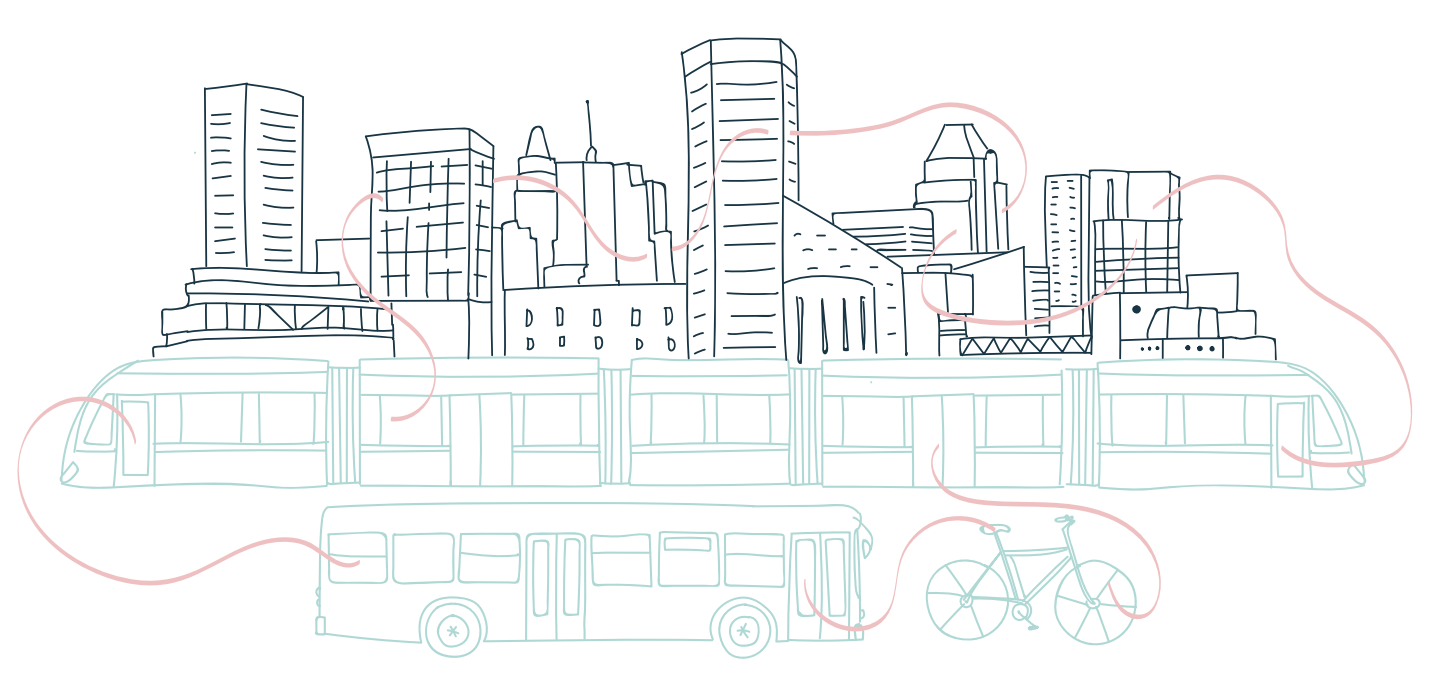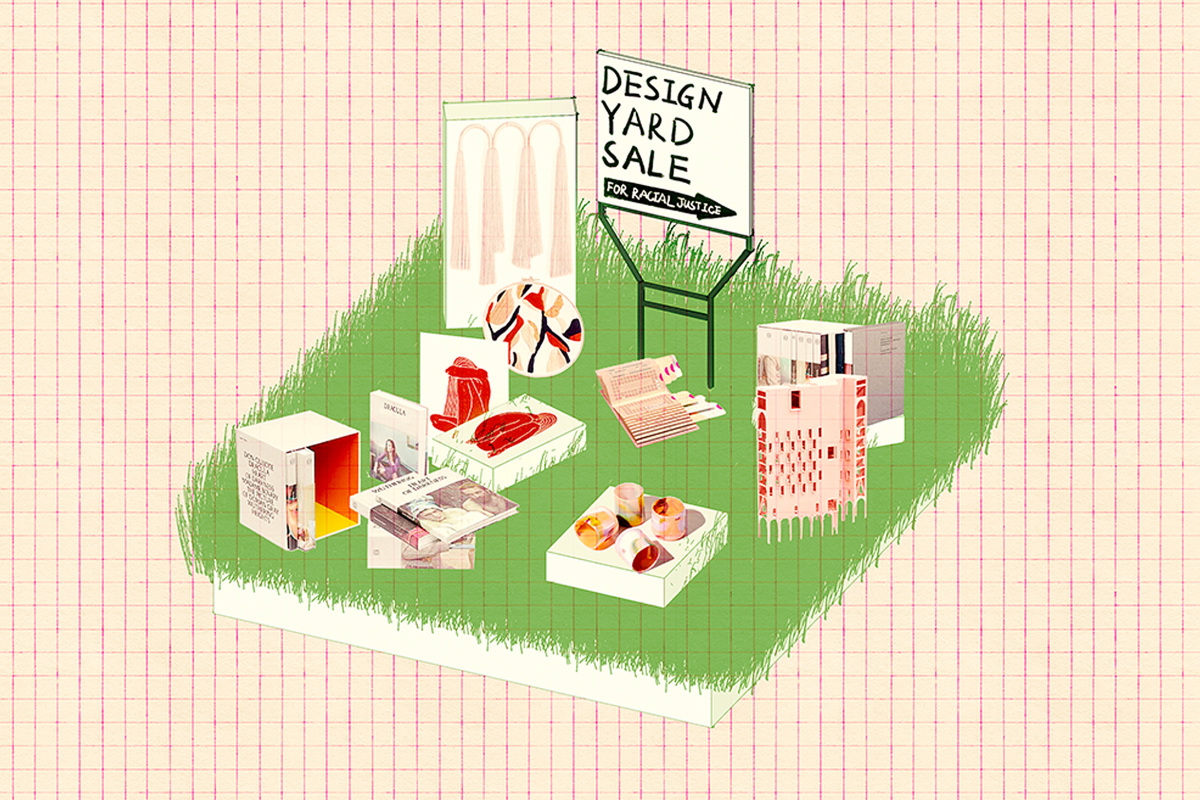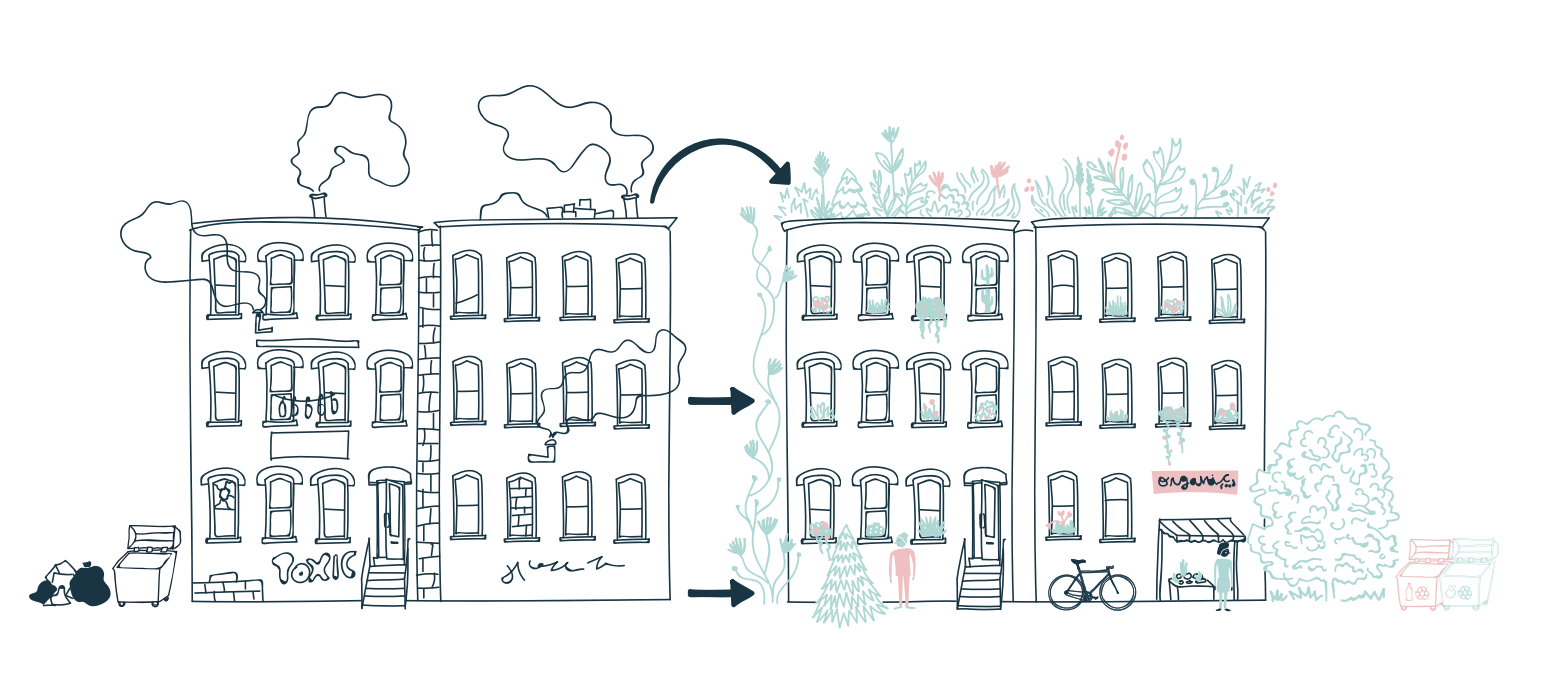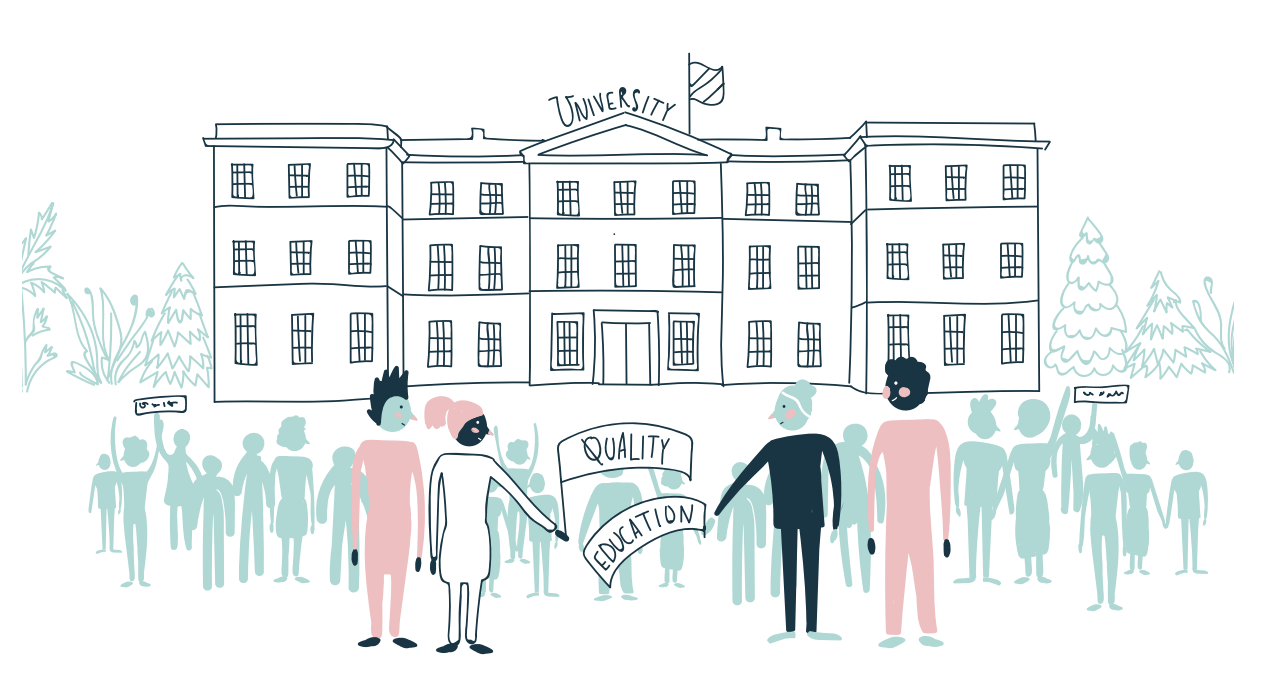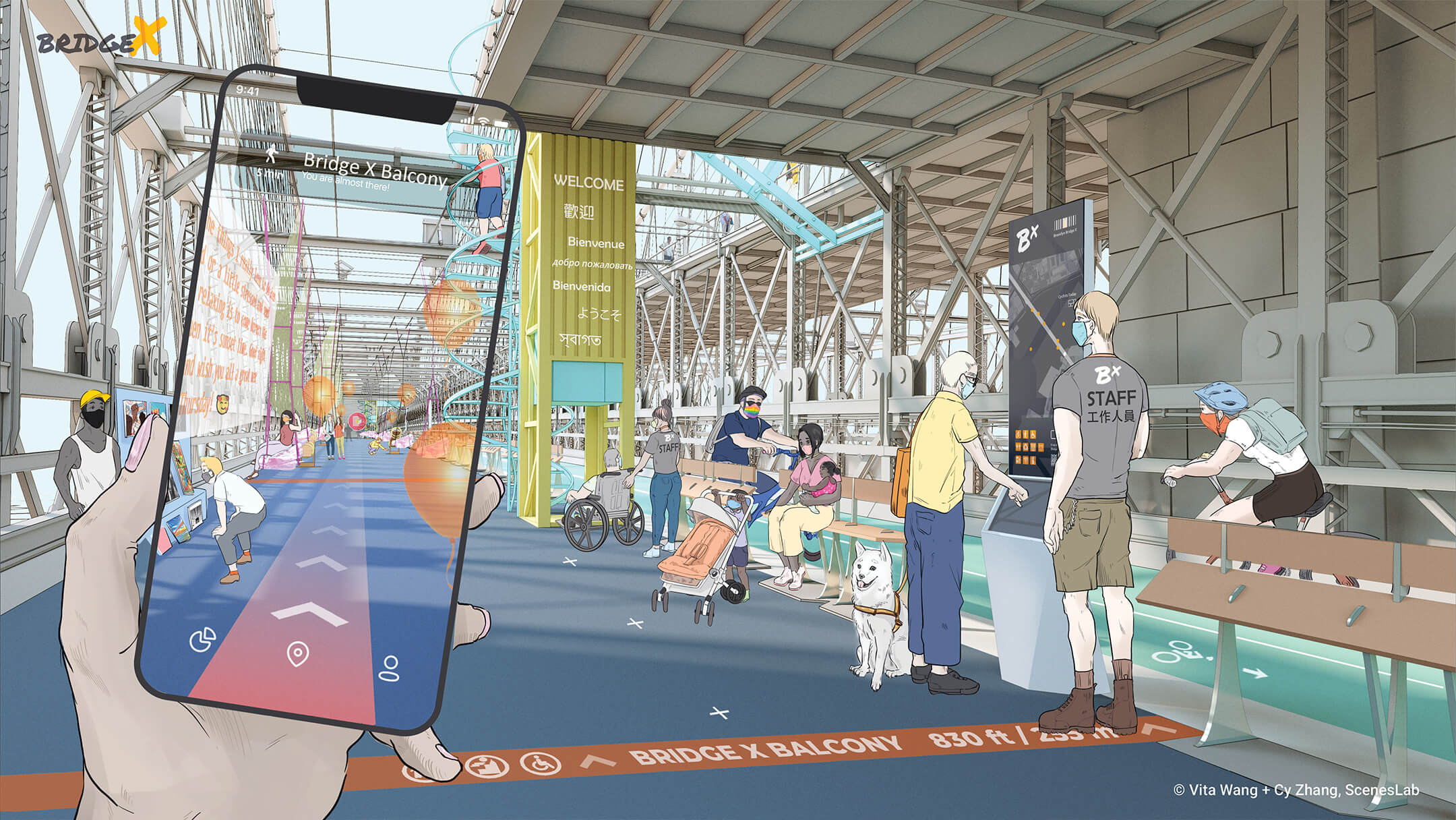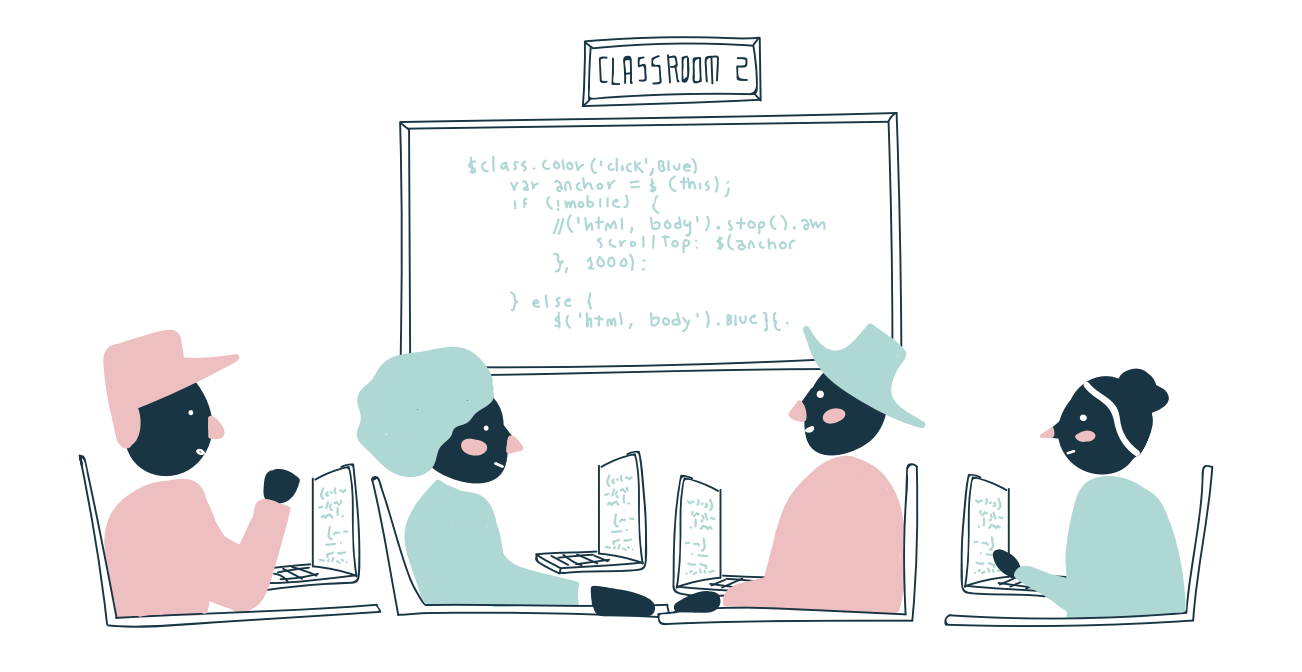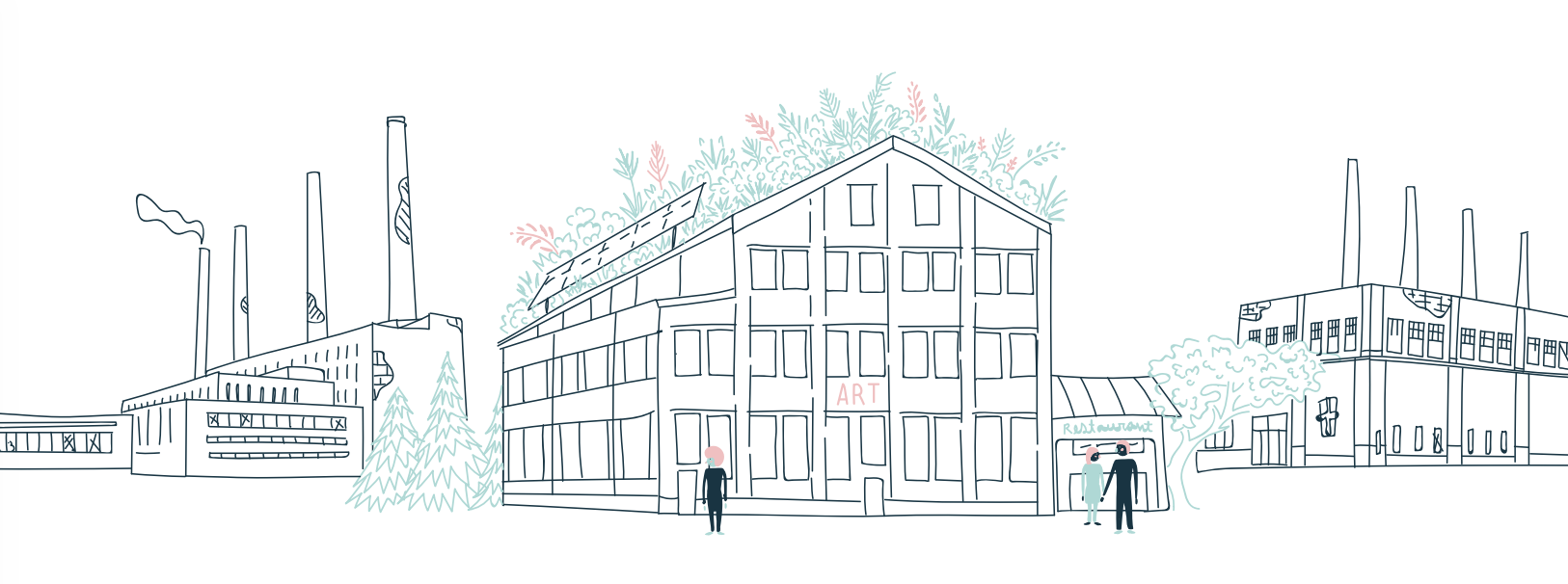Architecture, Design, Action: Erika Naginski on Dismantling Systemic Racism in Pedagogy and Practice
Excerpt: The Long Ride, by Scot T. Spencer
“Five years ago, the Harvard Graduate School of Design’s Just City Lab published The Just City Essays: 26 Visions of Inclusion, Equity and Opportunity. The questions it posed were deceptively simple: What would a just city look like? And what could be the strategies to get there? These questions were posed to mayors, architects, artists, philanthropists, educators and journalists in 22 cities, who told stories of global injustice and their dreams for reparative and restorative justice in the city.
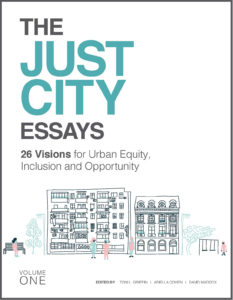
These essays were meant as a provocation, a call to action. Now, during these times of dissonance, unrest, and uncertainty, their contents have become ever more important. For the next 26 weeks [starting June 15, 2020], the GSD and the Just City Lab will republish one essay a week here and at designforthejustcity.org . We hope they may continue conversations of our shared responsibility for the just city.
We believe design can repair injustice. We believe design must restore justice, especially that produced by its own hand. We believe in justice for Black Americans. We believe in justice for all marginalized people. We believe in a Just City.”
—Toni L. Griffin, Professor in Practice of Urban Planning, founder of the Just City Lab , and editor of The Just City Essays
The Long Ride
By Scot T. Spencer
If you have never been to Baltimore, you should come to visit. From Baltimore Washington International Thurgood Marshall Airport, you can ride the light rail to downtown in 25 minutes for one of the best deals in the country. If you ride the train between Boston and Washington, you can walk out of Pennsylvania Station and board the Charm City Circulator to downtown, and it’s free! However, if you live in the city of Baltimore and you want to rely on transit to get you to all of life’s functions, you need to recalculate your aspirations for life’s necessities and ambitions. For the 30 percent of people who live in Baltimore without a car (which, coincidentally corresponds with the percentage of people between 16 and 64 not in the labor force), the pursuit of economic opportunity, particularly beyond the confines of downtown, comes with limitations.
The above example serves as powerful reminder of how access to opportunity, transit mobility and the missing luxury of transportation choice is a critical gap in the path to shared prosperity for many in places like Baltimore. It is equally important to understand and underscore that fostering a more just place that includes all, especially those with the most limited means, is not a zero-sum game, but can create greater benefits for everyone. Continue reading on designforthejustcity.org …
Student-organized Design Yard Sale raises $126,000 to benefit anti-racism organizations
With Design Yard Sale , a cohort of five Harvard Graduate School of Design students and recent graduates aims to both raise awareness of social and racial justice in design, and directly support anti-racism organizations.
Officially launched on July 1, Design Yard Sale has operated like a virtual auction and gift shop. Its catalog has included a curated range of original sketches, paintings, furniture, books, and apparel, many of which have been both donated and autographed by their designers—among them, Virgil Abloh, Denise Scott Brown, and Frank Gehry.

Design Yard Sale raised $126,000 through its four weeks of sales, with all proceeds benefiting a pair of non-profit organizations dedicated to anti-racist efforts.
Design Yard Sale’s organizers—Grace Chee (MArch ’21), Tessa Crespo (MDes ’20), Edward Han (MArch ’21), Izzy Kornblatt (MDes ’19), and Yaxuan Liu (MArch ’21)—first began conversing via GSD community emails and listservs in late May. Motivated by ongoing social-justice conversations, and catalyzed by the killing of George Floyd by a white police officer, the team felt driven to rewire design’s agency amid a national reckoning on race and justice, one in which the design fields have been directly implicated.
The Design Yard Sale cohort set up the project with no prior fundraising experience, learning and organizing on the fly. Proceeds of Design Yard Sale will benefit two organizations: nonprofit The Bail Project and New Orleans-based architecture and design justice practice Colloqate Design , each of which is dedicated to fighting systemic racism.
“In the face of such deeply rooted violence and oppression, we questioned what role we could play, and as minority designers and students ourselves, we wanted to contribute to the movement in whatever small way we could,” says Chee. “As Jerome Byron, one of our contributors, put it, Design Yard Sale is about promoting strategies for personal spending and redirecting cash to where it matters most.”
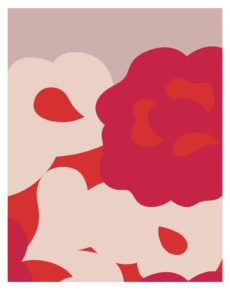
The auction’s final lot, which closed last Saturday, August 1, included a signed X-Rocker stool from Herzog & de Meuron and a print of Simone by Farshid Moussavi. Individual works of particular interest have included a a sketch of Queens Public Library by Craig Dykers; photographs of 1960s Las Vegas by Denise Scott Brown; and a sketch of Beekman Street Housing by Frank Gehry, each framed and signed by their respective designer. Jerome Byron offered a glass-fiber-reinforced concrete stool, infused with pink pigment. Other standout items included a Virgil Abloh™ x IKEA MARKERAD Chair from Abloh’s personal archive, to be illustrated on and signed by Abloh with the purchaser’s name, as well as Perry Kulper prints and Harvard GSD’s Womxn in Design Takeout Tote.
Among other ideas, the concept of offering distinctive design items—including furniture and other consumer goods, but also books, sketches, and other works that evoke design’s pedagogical and conceptual undercurrents—arose as a constructive way to celebrate both design’s tangible fruits, and its potential for social agency.
“It was a call to action with a direct, tangible way to help, and that really appealed,” says Crespo. “We all felt a strong obligation to fight against systemic racism and we wanted to do so in a way that provided immediate assistance to leaders on the front lines of the movement.”
For Design Yard Sale’s five organizers, the month of June was a warp-speed crash course in establishing a non-profit organization. Liu initiated e-mail conversations in May; as the team took shape, Han began establishing and deepening an online presence for the growing effort. A first public call for donations went out on the Design Yard Sale Instagram on June 18.
Before and following this first activation, the team strategized Design Yard Sale’s entire scope, from establishing an e-commerce platform to sourcing design objects—not to mention pricing, marketing, and shipping them—as well as studying the relevant international laws and policies governing commercial transactions.
The group secured fiscal sponsorship from the Architectural League of New York with less than 24 hours to spare before the July 1 launch; they set up a bank account that morning, and by that afternoon were starting to ship orders.
Sourcing the auction’s exquisite, unique wares was a similarly collaborative process, if less manic: organizers both tapped into professional and academic networks in order to solicit donated works, but also were approached by various members of the Harvard GSD community as word spread. Among Harvard GSD faculty efforts, Toshiko Mori and Oana Stănescu provided mentorship to the organizers, as well as connections to other designers; Jerold Kayden and colleagues at Harvard’s Transactional Law Clinic helped guide the team through legal considerations; and a variety of faculty—among them Jennifer Bonner, Sean Canty, Jon Lott, Chris Reed, Jeannette Kuo, Malkit Shoshan, Jenny French, Sara Zewde, and Zeina Koreitem—donated works of their own. A full list of Design Yard Sale contributors is on view at the project’s homepage .
At the project’s roots, foregrounding student work was a cornerstone of the cohort’s organizing vision. First batches of donations included models and drawings from fellow Harvard GSD students, while faculty grew involved as word spread. While early conversations among organizers involved questions of which types and mediums of items to include, the team ultimately chose an open approach, inviting works from a range of designers and at a range of price points, enhancing the auction’s accessibility.
“For us, it has always been really important to have student and young-practitioner work be presented on an equal footing with that of better known designers, because so often student work goes unnoticed,” says Kornblatt. “We know of the high caliber of work that happens at the GSD and other design schools, but so much of it ends up just gathering dust. Design Yard Sale allows students to use what they’ve already created to make a difference.”
In serving anti-racist priorities and missions, the team wanted to support both smaller, grassroots work, and broader efforts tackling systemic, anti-Black racism in the criminal justice system. Amid conversations with social-justice-minded colleagues, as well as a poll among Harvard GSD students, organizations the Bail Project and Colloqate Design emerged.
Beyond the July auctions, Design Yard Sale aims to educate and inspire awareness of social justice and systemic racism, especially within but also beyond design. The organizers are considering the project’s future, whether that involves making it an annual tradition, extending it into the Fall 2020 term, or other avenues toward expansion. And, individually, each is conceptualizing other projects geared toward promoting racial justice and equality within the field; Chee recently began developing an Instagram-based storytelling and archival project to chronicle designers of color and their work.
“While the DYS store is closing today, the fight does not end here,” the project’s website reads. “We hope that we can all continue to take part in the long-term battle against racism, both within the design field and in the wider society. In the face of such deep-rooted, systemic violence and oppression, we should never forget the implications that our everyday choices—be it what we read, where we spend, or who we hire—have on creating a better and more equitable future.”
Excerpt: An Antidote for the Unjust City: Planning to Stay, by Mindy Thompson Fullilove
“Five years ago, the Harvard Graduate School of Design’s Just City Lab published The Just City Essays: 26 Visions of Inclusion, Equity and Opportunity. The questions it posed were deceptively simple: What would a just city look like? And what could be the strategies to get there? These questions were posed to mayors, architects, artists, philanthropists, educators and journalists in 22 cities, who told stories of global injustice and their dreams for reparative and restorative justice in the city.

These essays were meant as a provocation, a call to action. Now, during these times of dissonance, unrest, and uncertainty, their contents have become ever more important. For the next 26 weeks [starting June 15, 2020], the GSD and the Just City Lab will republish one essay a week here and at designforthejustcity.org . We hope they may continue conversations of our shared responsibility for the just city.
We believe design can repair injustice. We believe design must restore justice, especially that produced by its own hand. We believe in justice for Black Americans. We believe in justice for all marginalized people. We believe in a Just City.”
—Toni L. Griffin, Professor in Practice of Urban Planning, founder of the Just City Lab , and editor of The Just City Essays
An Antidote for the Unjust City: Planning to Stay
By Mindy Thompson Fullilove
In 1993 or thereabouts I entered a contest for women to depict what they did on a particular day. That day, I went to meetings early in the morning at Harlem Hospital. I took photos of the abandoned buildings on West 136th, where I parked my car, and photos of a huge plastic bag in one of the stunted trees. Later, on my way back to my office on W. 166th Street, I stopped to take a photo of man who was selling nuts on the street in front of a burned-out building. He smiled with tremendous pride—when I took him a copy of the photo a few weeks later, he grinned and said he’d send it to his mother so she would know he was trying to make something of himself. There were photos of the Stuyvesant High School students that I was mentoring for the Westinghouse Science Competition, and photos at home in Hoboken with my daughter Molly and some chocolate chip cookies fresh out of the oven. We were reading Ian Frazier’s New Yorker article about plastic bags in trees. I didn’t win the contest, but the exercise etched what I saw in memory.
Harlem had been devastated by decades of policies of disinvestment. Walking the streets was a painful experience because so many of the buildings had been burned out, and garbage blew in the courtyards and rats ran in and out. Working people were struggling to control the neighborhood, but drugs and violence were the order of the day. Most of my research was focused on describing the problems in front of me—filling out our understanding of a terrible statistic reported in 1990 by Drs. Harold Freeman and Colin McCord: that a black man living in Harlem had a shorter life expectancy than a man in Bangladesh, at that time the poorest country on earth. Some of what I wanted to describe was the historical process that had stripped this neighborhood of its life-giving qualities. I was describing an unjust city. Continue reading on designforthejustcity.org …
Work in Progress: Edgar Rodriguez’s Cross-Laminated Timber Experiments
Edgar Rodriguez (MArch ’20) describes his final project for the option studio “Mass Timber and the Scandinavian Effect” led by Jeniffer Bonner and Hanif Kara, spring 2020.
Excerpt: Resistance, Education and the Collective Will of the Just City, by Jack Travis
“Five years ago, the Harvard Graduate School of Design’s Just City Lab published The Just City Essays: 26 Visions of Inclusion, Equity and Opportunity. The questions it posed were deceptively simple: What would a just city look like? And what could be the strategies to get there? These questions were posed to mayors, architects, artists, philanthropists, educators and journalists in 22 cities, who told stories of global injustice and their dreams for reparative and restorative justice in the city.

These essays were meant as a provocation, a call to action. Now, during these times of dissonance, unrest, and uncertainty, their contents have become ever more important. For the next 26 weeks [starting June 15, 2020], the GSD and the Just City Lab will republish one essay a week here and at designforthejustcity.org . We hope they may continue conversations of our shared responsibility for the just city.
We believe design can repair injustice. We believe design must restore justice, especially that produced by its own hand. We believe in justice for Black Americans. We believe in justice for all marginalized people. We believe in a Just City.”
—Toni L. Griffin, Professor in Practice of Urban Planning, founder of the Just City Lab , and editor of The Just City Essays
Resistance, Education and the Collective Will of the Just City
By Jack Travis
“What has happened is that in the last 20 years, America has changed from a producer to a consumer. And all consumers know that when the producer names the tune, the consumer has got to dance. That’s the way it is. We used to be a producer—very inflexible at that, and now we are consumers and, finding it difficult to understand. Natural resources and minerals will change your world. The Arabs used to be in the third world. They have bought the second world and put a firm down payment on the first one. Controlling your resources will control your world. This country has been surprised by the way the world looks now. They don’t know if they want to be Matt Dillon or Bob Dylan. They don’t know if they want to be diplomats or continue the same policy—of nuclear nightmare diplomacy. John Foster Dulles ain’t nothing but the name of an airport now… . The idea concerns the fact that this country wants nostalgia. They want to go back as far as they can—even if it’s only as far as last week. Not to face now or tomorrow, but to face backwards. And yesterday was the day of our cinema heroes riding to the rescue at the last possible moment. The day of the man in the white hat or the man on the white horse—or the man who always came to save America at the last moment— someone always came to save America at the last moment—especially in “B” movies. And when America found itself having a hard time facing the future, they looked for people like John Wayne. But since John Wayne was no longer available, they settled for Ronald Reagan and it has placed us in a situation that we can only look at like a ‘B’ movie.”—Gil Scot Heron, “B-Movie,” 1981 “If the Negro is not careful he will drink in all the poison of modern civilization and die from the effects of it. Ultimately it will do us very little good to simply get more opportunities in the Global South or elsewhere if we do not ask ourselves and resolve the question, ‘Do we really want to continue to design while mimicking the kinds of socio-political society that marginalized us in the first place?” —Marcus Garvey
What makes great buildings, spaces and places? It is when those structures or spaces reflect and serve the people of the community for which they are intended. It is when they lift the spirit while providing shelter and functional use; when they foster positive aesthetic and tactile relationships between the buildings, spaces and/ or places themselves and the people they are intended to serve.
I penned that statement more than 20 years ago at a moment when I was striving to define my practice as an architect and interior designer. It was relevant then and remains so today as we struggle to imagine a just city being born out of the troubled world we occupy today. Continue reading on designforthejustcity.org …
Alumni cohort among finalists in “Reimagining Brooklyn Bridge” competition
A team of Harvard Graduate School of Design alumni is among the six finalists in a competition being held by the New York City Council and the Van Alen Institute to reimagine New York’s Brooklyn Bridge as a friendlier experience for cyclists and pedestrians, entitled “Reimagining Brooklyn Bridge .” The team comprises GSD alumni Wendy Wang (MLA ’14), Cy Zhang (MLA/MLAUD ’20), Vita Wang (MArch ’19), Jeremy Pi (MUP ’19), and Minzi Long (MAUD/MDes ’20), as well as designers Shannon Hasenfratz and Andrew Nash.
“The Brooklyn Bridge has the potential to serve as a testing ground for designs that serve our communities in need — not just in an imagined, idealistic future — but now,” writes the Van Alen Institute. “With these considerations at heart, the six finalist proposals are a compelling and optimistic set of ideas for responsive short-term interventions and longer-term, large-scale reconfigurations of the Brooklyn Bridge.”
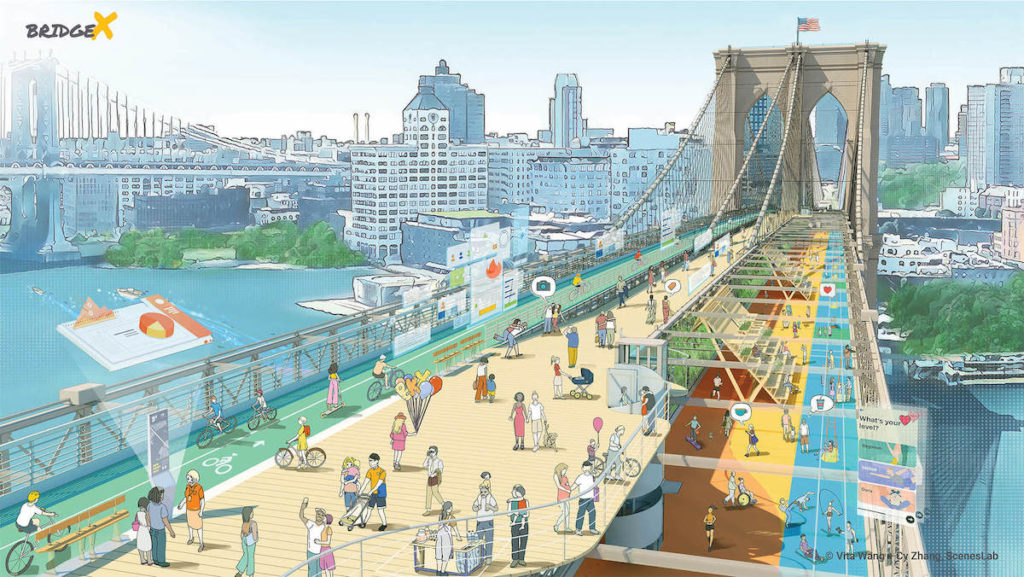
According to the competition website, the team’s proposal, “Bridge X,” reimagines the upper and lower decks to reclaim space for greater pedestrian and cyclist access, to make room for vendors and small businesses, and to offer new modes of engagement with the bridge. Digital tools and design interventions enable visitors to more easily access, explore, and reflect on their experiences of the bridge, while the bridge itself evolves in response to public feedback and adapts from a pandemic to a post-pandemic era. The team submitted their proposal via Wang’s ScenesLab, which she founded as a platform for experimentation and research.
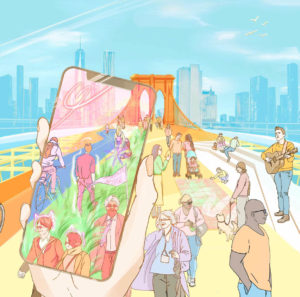
“Bridge X” was named one of three finalists in the competition’s Professional category, alongside collaborative entries from Bjarke Ingels Group and Arup Group, and from Pilot Projects Design Collective, Cities4Forests, Wildlife Conservation Society, Grimshaw and Silman. A second category, Young Adults, sought designers under the age of 21 to propose their “wildest dreams,” and also named three finalist projects. The competition jury named these six finalists from among 250 collective submissions.
“Reimagining Brooklyn Bridge” was launched in February 2020, and the ensuing Covid-19 pandemic recast the competition’s mission, though not fundamentally. “As made even more clear by the pandemic, the design of our streets and shared spaces must be responsive to the present moment and work to correct past injustices,” the Van Alen Institute writes. “They must foster equitable, accessible, and sustainable transportation options, create a healthy and safe environment for all New Yorkers, and opportunities for small businesses and vendors to flourish.”
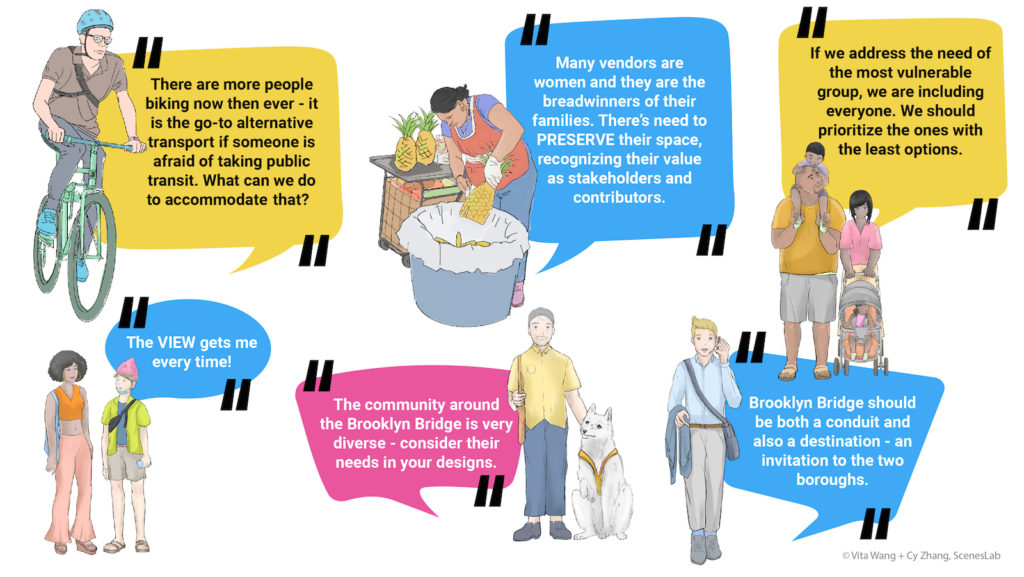
According to the Van Alen Institute, the competition’s finalists were selected by an interdisciplinary jury representing a wide-ranging set of perspectives on the Brooklyn Bridge. The jury considered the following factors: team composition; accessibility and safety; environmental benefit and security; respect for the bridge’s landmark status; feasibility; and “magic”—i.e. new ideas that surprise, delight, and fascinate.
The three Professional category finalist teams present their proposals during a public, virtual “Design Showdown” on Thursday, July 23, when the jury and viewers will have an opportunity to offer feedback on each design. Each project is also available online , and viewers can cast votes for their favorite proposals between July 23 and 30. A winner will be announced in late summer.
The New York City Council said the city’s Department of Transportation would review these proposals as part of a planned assessment of the bridge.
“As we undertake our own engineering inspection this year to help assess the capacity for changes to the promenade, we welcome new and innovative ideas on how to reimagine the Brooklyn Bridge Promenade to create more space for pedestrians and cyclists,” Margaret Forgione, the chief operations officer of the city’s Transportation Department, told the Wall Street Journal .
Excerpt: The Case for All-In Cities, by Angela Glover Blackwell
“Five years ago, the Harvard Graduate School of Design’s Just City Lab published The Just City Essays: 26 Visions of Inclusion, Equity and Opportunity. The questions it posed were deceptively simple: What would a just city look like? And what could be the strategies to get there? These questions were posed to mayors, architects, artists, philanthropists, educators and journalists in 22 cities, who told stories of global injustice and their dreams for reparative and restorative justice in the city.

These essays were meant as a provocation, a call to action. Now, during these times of dissonance, unrest, and uncertainty, their contents have become ever more important. For the next 26 weeks [starting June 15, 2020], the GSD and the Just City Lab will republish one essay a week here and at designforthejustcity.org . We hope they may continue conversations of our shared responsibility for the just city.
We believe design can repair injustice. We believe design must restore justice, especially that produced by its own hand. We believe in justice for Black Americans. We believe in justice for all marginalized people. We believe in a Just City.”
—Toni L. Griffin, Professor in Practice of Urban Planning, founder of the Just City Lab , and editor of The Just City Essays
The Case for All-In Cities
By Angela Glover Blackwell
People of color are at the center of a demographic shift that will fundamentally change the global urban landscape. From the growing proportions of Latino, Asian, and African American residents in resurgent cities of the United States, to the diversifying capitals of Europe and the booming metropolises of Asia, Africa, and Latin America, cities populated by people of color are emerging as the new global centers of the 21st century.
Full inclusion is a challenge in nearly all of these urban communities, as local leaders struggle to both address the needs and harness the talents of their diversifying populations. The challenge may stem from rural to urban relocation, historical and continuing prejudice, migration within countries, or immigration. In the United States, this challenge is characterized most noticeably by race and ethnicity.
Before the middle of this century, the United States will become majority people of color; many American cities have already crossed that mark. This seismic shift requires a redefinition of the meaning of success for cities. How will cities reflect and advance the world we want to live in? How will they foster health and allow all residents to reach their full potential? Fundamental to these questions is the issue of inclusion: how will cities engage those who have traditionally been marginalized, excluded, ignored, or reviled because of race, religion, ethnicity, caste, gender or national origin? Continue reading on designforthejustcity.org …
The Nexus Podcast
As countless industries and sectors reckon with the aims articulated by the Movement for Black Lives and other aligned groups, the African American Design Nexus is on a mission to elevate the work and roles of Black designers. Founded in the wake of the GSD’s first Black in Design Conference in 2015, the Design Nexus is a collaboration between the school’s African American Student Union and the Frances Loeb Library. It’s a preeminent resource for those interested in the intersection of Blackness and design practices throughout the built environment as well as those represented in “public art, fashion, music, movies and other media.”

Now, its mission will be further animated by a new podcast featuring Black scholars, writers, designers, and educators. As hosts of The Nexus , GSD students Tara Oluwafemi and Caleb Negash aim to ensure that the podcast records and preserves the legacy of Black designers working today, and they plan to push the understandings of the boundaries of design in the most expansive ways possible. They anticipate that The Nexus will introduce listeners to designers who represent exciting interventions within the field, but who may not be household names yet. For Oluwafemi, for example, dream guests include Nigerian designer Mowalola Ogunlesi and acclaimed artists Toyin Ojih Odutola and Jacolby Satterwhite.
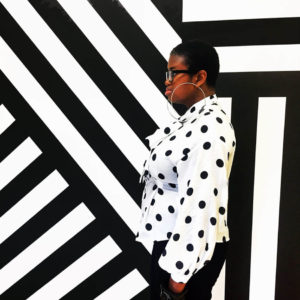
The Nexus’s inaugural episode features Boston-based architect, filmmaker, illustrator, and children’s book author Aisha Densmore-Bey . It is a conversation that ranges from what it means to be a polymath, to Densmore-Bey’s personal influences, to her relationship to art, joy, and beauty. The mood of this dialogue—an intimate, nuanced inquiry that critically traverses the geographies of design—is illustrative of what Oluwafemi and Negash seek to capture throughout the entire series. As the two continue to assemble a dynamic roster of interviewees, including Stephen Gray, De Nichols, and Bryan Lee Jr., they are looking forward to playing, experimenting, and sharpening their own skills as storytellers.
Ultimately, The Nexus will add to the broader intellectual ecology that is the African American Design Nexus and will contribute to the Loeb’s ongoing open access bibliography that makes available key texts related to “the intersection of race and design.” This effort of documentation, historicization, and preservation, as Oluwafemi and Negash explain to me, will be strengthened by the voices they plan to amplify and celebrate.
Excerpt: Home-Grown Justice In a Legacy City, by Karen Freeman-Wilson
“Five years ago, the Harvard Graduate School of Design’s Just City Lab published The Just City Essays: 26 Visions of Inclusion, Equity and Opportunity. The questions it posed were deceptively simple: What would a just city look like? And what could be the strategies to get there? These questions were posed to mayors, architects, artists, philanthropists, educators and journalists in 22 cities, who told stories of global injustice and their dreams for reparative and restorative justice in the city.

These essays were meant as a provocation, a call to action. Now, during these times of dissonance, unrest, and uncertainty, their contents have become ever more important. For the next 26 weeks [starting June 15, 2020], the GSD and the Just City Lab will republish one essay a week here and at designforthejustcity.org . We hope they may continue conversations of our shared responsibility for the just city.
We believe design can repair injustice. We believe design must restore justice, especially that produced by its own hand. We believe in justice for Black Americans. We believe in justice for all marginalized people. We believe in a Just City.”
—Toni L. Griffin, Professor in Practice of Urban Planning, founder of the Just City Lab , and editor of The Just City Essays
Home-Grown Justice In a Legacy City
By Karen Freeman-Wilson
I am the mayor of a legacy city, a city that rose and fell on the fluctuations of an industrial marketplace. Like Detroit, Cleveland, and dozens of other cities that have experienced continuous population and job loss since their peak, my hometown of Gary, Indiana, once provided the backbone of the nation’s economy. These cities led the way in educational innovation, architectural design and cultural development. In the 1920s, Gary earned the nickname of Magic City because of its exponential growth. Seventy years later, one half of the city’s population is gone, leaving an overwhelming inventory of vacant and abandoned buildings, a nearly 40 percent unemployment rate and a 35 percent poverty rate in the rear view mirror.
Despite the devastating statistics, Gary is home to people who continue to remain faithful after others left. These individuals are raising children, purchasing and maintaining homes, pursuing business opportunities and continuing to invest their time, talent and treasure in a city that some said was not worth the energy. These individuals are my neighbors, fellow church members, former teachers and classmates. My just city is dedicated to these legacy residents. Together, we must retool Gary into a city that better serves all of us. This is undoubtedly a complex proposition that requires vision, planning, faith, resilience and cheerleading. Continue reading on designforthejustcity.org …
